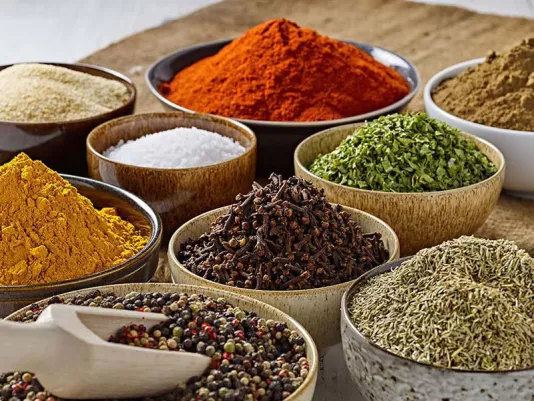Potatoes and Eggplants with Coconut
Potatoes and eggplants with coconut – recipe for cooking Indian cuisine, vegetables are pre-steamed.

Garam Masala is not just a spice mix but a reflection of the balance of flavor I value in everyday cooking. Over the years, I’ve learned to sense the proportions without measuring: a pinch of cinnamon for warmth, a bit of cardamom for freshness, cumin seeds for depth. A good garam masala has an aroma that immediately awakens the appetite – not sharp, but complex, with a gradual unfolding of notes. It enhances stewed meats, creamy sauces, and vegetable dishes equally well. The main rule is not to over-roast the spices, as they lose the oils that create their signature aroma. In my kitchen, garam masala is the finishing touch that adds depth and comfort to a dish.
Through years of cooking, I’ve learned that the quality of garam masala is defined not by bright packaging but by the purity of its aroma. When I open the jar, the blend should smell warm and complex, with no traces of stale oil or dust. If the scent feels dull or bitter, the spices have lost their potency. In store-bought blends, it’s worth checking the ingredients list – a good one contains only spices, with no salt, flour, or flavorings. I often buy the spices separately and mix them myself to control the balance. For mild vegetable dishes, I reduce the amount of black pepper, while for stewed meat, I add more cloves and cinnamon. It’s important to store garam masala in glass containers with tightly fitting lids, in a dry, dark place. Sunlight and moisture destroy essential oils faster than expected. Over time, I noticed that the best aroma lasts for about six months after blending. That’s why I never make large batches – it’s better to refresh the mix often than to keep an old, faded one.
In my practice, preparing garam masala begins with lightly toasting the spices in a dry pan. This awakens their aroma and deepens the flavor. I use medium heat so the seeds don’t burn – a few minutes are enough until they start to release fragrance. Once the spices cool, I grind them in a coffee grinder into a fine powder. Everything must be done in dry cookware, as even slight moisture can spoil the mix and make it sticky. If garam masala includes cinnamon, nutmeg, or cloves, I add them at the end of grinding – they are very aromatic, and too much can overpower the other notes. I also recommend sifting the blend through a fine sieve: small particles dissolve more evenly in dishes. This gives a smooth, rounded flavor without any dominant spice. The key is not to grind large quantities in advance. Even in airtight containers, the aroma starts to fade after a few weeks.
Garam masala doesn’t develop through long boiling but through contact with heat. I always add it at the end of cooking when the dish is almost ready and the heat is low. If added too early, the essential oils evaporate, leaving only bitterness instead of depth. In dishes with butter or cream, the spices dissolve better, giving a softer aroma. When I cook without fat, I sometimes briefly warm the garam masala in a spoonful of oil before adding it to the main dish. This creates a fragrant concentrate that distributes evenly. If cooked over high heat, the spices can burn and develop a bitter taste – something to avoid. For soups or sauces, it’s enough to remove the pot from the heat, wait until the boiling subsides, and then add the blend. This method keeps the aroma rich but not harsh.
Garam masala pairs wonderfully with meat, especially beef and lamb, as its warm notes balance their richness. I also love adding it to lentils, chickpeas, pumpkin, carrots, and cauliflower – the vegetables gain a pleasant sweetness and depth. If a dish includes tomatoes, their acidity enhances the spice blend’s warmth. In yogurt-based sauces, garam masala adds flavor complexity without excessive heat. Over the years, I’ve learned to feel the balance: too much spice makes a dish heavy, too little makes it flat. The ideal result is when after the first spoonful, you want to breathe in the aroma again. This blend is worth combining not only with traditional ingredients but also in experiments: I’ve added it to pumpkin cream soup and baked chicken with lemon – both turned out wonderfully.
The most common mistake is using old or over-roasted blends. When spices are overheated, they darken and lose their essential oils, replacing warmth with bitterness. Garam masala should also not be stored in open containers near strong-smelling foods – it quickly absorbs odors. Another mistake is overusing it. Spices should highlight the flavor, not mask it. I always recommend starting with half a teaspoon per serving for four people and adjusting gradually. If the blend looks grayish or smells dull, it’s a sign of fading. In that case, it’s better to prepare a new batch. In my experience, quality control is a habit: once a month, I check all spices, assessing their color and aroma. This way, I’m sure every dish receives the intended fragrance. It’s a simple yet essential part of a professional approach.